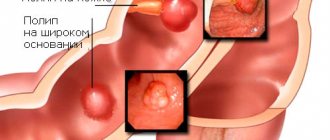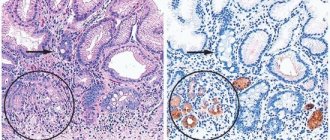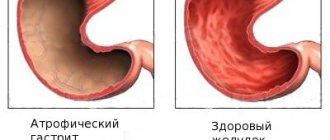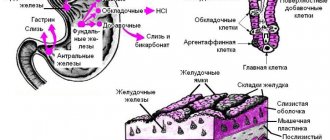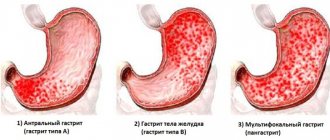Atrophic gastritis is a long-term form of chronic disease in which destructive changes occur in the gastric mucosa. As a result of the pathological process, its area and the number of functioning cells decrease sharply. Many experts believe that this subtype of chronic gastritis is a precancerous condition, and as a result, the threat of developing a malignant process is very high.
With atrophic gastritis, the mechanism of degeneration of normal stomach cells that produce gastric juice is triggered. Instead, they begin to produce mucus. As a result, gastric acid decreases sharply. The fact that cells change their specialization and cease to perform their main function indicates that the body has a malfunction in the system of hormonal, immune, enzyme and other regulators of physiological processes.
Moderately severe atrophic gastritis, according to WHO, is a very common disease. To one degree or another, every third inhabitant of the planet has atrophic changes in the gastric mucosa. Although the disease is considered age-related, it is currently observed even in young children. Is it possible to cure atrophic gastritis? Unfortunately, patients seek medical help already in an advanced stage. This is due to the fact that in the initial stage atrophic gastritis is practically asymptomatic.
Causes of the disease
What is atrophic gastritis? According to the theory that is accepted at this stage, it is believed that the pathogenesis of the disease develops in 2 stages.
First stage. Under the influence of a number of external and internal factors that constantly attack the glandular cells of the stomach, inflammation occurs, which quickly becomes chronic. Scientists have not yet reliably studied the causes of atrophic gastritis.
Factors that lead to the development of gastritis:
- External - irregular nutrition, eating heavy meat and smoked dishes, too hot or cold food; exposure to toxic substances - lead, coal and cotton dust, arsenic, alcohol, nicotine and tobacco tar.
- Internal - disruption of the nervous and hormonal regulation of the stomach, atrophy in the regeneration system of the glandular epithelium, insufficient blood supply to the walls of the stomach, the action of infectious microorganisms.
Second phase. Autoimmune changes in the body, leading to the fact that immature cells of the glandular epithelium do not acquire the specialization required by nature. Old glandular cells that produce gastric juice are replaced by young ones that produce mucus instead of juice. It has protective properties, but does not participate in digestive processes.
Atrophic gastritis with high acidity can have a focal course. Areas with degenerated cells appear on the gastric mucosa, while normal areas of the mucosa continue to produce gastric juice. Focal gastritis occurs with increased acidity.
Atrophic gastritis of the antrum of the stomach is characterized by the development of scar tissue in place of normal mucosa. Due to inflammation, the lumen of the outlet from the stomach into the duodenum narrows, food stagnates, and putrefactive and fermentation processes develop in it.
Classification
In medicine, there are several classifications of gastropathy. According to one of them, the disease is divided into acute and chronic, according to another, the disease is distinguished by stages, and still others distinguish the degrees of development of the pathology. According to the degree of development of the disease, gastropathy is:
- 1st degree, which is manifested in a slight change in the gastric mucosa, as well as a slight decrease in the production of hydrochloric acid;
- 2nd degree, which is caused by more severe pathological processes, cell damage and necrosis of the gastric epithelium passes faster than in the first case. But these changes are convertible if treatment is started in a timely manner.
According to its form, the disease is divided into:
- Acute gastropathy, which occurs when the stomach is exposed to alcohol, acids or alkalis, infections;
- Chronic, characterized by a slow course with a gradual change in the epithelium of the organ, its atrophy, and a decrease in the functions of the stomach. In frequent cases, this form of the disease is asymptomatic;
- Moderate gastropathy, which is caused by the transformation of epithelial cells into connective tissue.
Atrophic changes in the stomach develop gradually; several stages (simultaneously and varieties) are distinguished in the process of chronic gastropathy:
- initial degree of atrophic degenerative changes;
- with atrophy - the appearance of multiple areas of atrophy, glandular structures begin to die, they are replaced by simple epithelial cells;
- chronic atrophic antral gastritis - degenerative processes reach the antrum of the organ, which indicates the progression of the disease;
- chronic multifactorial atrophic gastritis is a form of diffuse atrophy with active metaplastic degeneration of mucosal tissue, the condition is classified as precancerous.
Chronic atrophic gastritis is the most dangerous type of gastropathy, which is a precancerous condition. The disease is associated with damage to the gastric glandular structures responsible for the secretion of digestive juices. The atrophic form leads to a gradual progressive thinning of the walls of the stomach; in parallel, the volume of healthy cells with intact functions decreases. In ICD-10, the disease is recorded with the assignment of code K29.4. The atrophic form with a chronic course, the symptoms of which are associated with degeneration and degeneration of the glands, requires timely examination and adequate treatment.
Chronic atrophic gastritis refers to a variety of chronic forms of inflammatory pathologies of the stomach. The disease often affects older people, which does not exclude its relevance among other age categories. The course of the pathology leads to atrophy of the mucous layer with the impossibility of subsequent restoration of the glands, while dysfunction of the immune system develops. A malfunction of the immune forces leads to the production of antibodies that destroy the glandular structures of the organ. As a result, the gastric mucosa is subjected to a double blow - from its own immunity and from primary factors.
Chronic gastritis with signs of mucosal atrophy in the initial stages affects the fundus of the stomach and the parietal cells located there. After cell damage, a failure occurs in the production of important components of gastric secretion - the zymogen pepsin and hydrochloric acid. As a result, the stomach cavity becomes inflamed, loses its protective properties, and trauma to the mucous layer occurs even from food entering the stomach.
Of important clinical significance is the area of the mucosa with atrophic changes. The larger it is, the higher the likelihood of metaplastic areas degenerating into areas of accumulation of malignant cells. Thus, in the presence of atrophic areas with metaplasia, occupying 20% of the total volume of the gastric mucosa, the probability of pathology turning into cancer is 100%. According to statistics, the chronic form of gastritis leads to cancer in more than 13% of cases.
https://youtu.be/oah3lPa0nLw
Symptoms and diagnosis of atrophic gastritis
The initial stages of the disease are practically asymptomatic. Further, the course of the disease is similar to that of ordinary gastritis.
We list the signs of atrophic gastritis and how to treat it:
- Stomach pain associated with eating appears.
- After eating there is a feeling of heaviness and fullness.
- The patient suffers from belching; with atrophic gastritis of the antrum, it is sour or rotten.
- Bloated belly.
- Constant nausea, sometimes vomiting, which brings a feeling of relief.
- Symptoms of atrophic gastritis are bad breath and a feeling of foreign taste.
- Problems with appetite.
- Flatulence and gurgling in the stomach.
- Loss of body weight.
- Stool disorder - diarrhea or constipation.
- Avitaminosis. Lack of B vitamins associated with malabsorption.
How to diagnose atrophic gastritis, symptoms and treatment in women and men?
A diagnosis can only be made on the basis of such instrumental studies as:
- Fibrogastroduodenia. On the camera screen, the doctor notes the thinning of the mucous layer, its pallor or gray color, smoothing of physiological folds, proliferation of the vascular network, and the presence of foci of pathological changes in the glandular epithelium. During the procedure, a biopsy of mucous membrane tissue is taken to exclude an oncological process.
- Ultrasound diagnostics. There is a narrowing of the size of the stomach.
- Functional assessment. According to objective data, the patient is determined to have a change in the pH level of gastric juice, as well as enzymatic deficiency.
Symptomatic manifestations
Focal atrophic superficial gastritis has a long-term course, in which lesions begin from the gastric fundus and gradually cover the entire organ.
The early stage is characterized by the following signs:
- anemia due to poor absorption of iron and vitamin B12;
- mild pain in the stomach and abdomen;
- dull pain after eating;
- heartburn, belching, nausea and vomiting.
Iron and folic acid deficiency causes the following manifestations of general malaise:
- chronic lack of sleep;
- impotence;
- chronic fatigue;
- skin and mucous surfaces are bloodless;
- numbness of the tongue and change in its color;
- loss of sensation in the arms and legs;
- hair and nails are dry and brittle;
- breathing problems;
- chest pain;
- burning sensation in the mouth.
Later stages of gastric pathology manifest themselves as follows:
- the tongue is covered with a thick white coating, on which, when pressed, teeth marks remain;
- sour taste in the mouth;
- intense pain in the epigastric region;
- nausea and vomiting with the presence of undigested food debris, mucus and bloody discharge in the vomit;
- foul belching;
- bowel dysfunction;
- bloating and increased gas production;
- loss of appetite and weight loss.
Important information: What can stool look like with gastritis?
Basic treatment methods
Conservative treatment of atrophic gastritis includes:
- drug treatment;
- diet therapy;
- use of the best methods of traditional medicine;
- special measures to restore the gastric mucosa;
- giving up bad habits, following a diet;
- sanatorium-resort treatment in health resorts of the appropriate profile.
Do not think that all patients with atrophic gastritis are doomed to stomach cancer. The body has serious defense mechanisms that prevent the growth of cancer cells. In addition, adequate treatment of gastritis of the stomach and compliance with doctor’s instructions remove the threat of further cell degeneration.
The gastric mucosa is normal
The inside of the stomach is lined with a thin and delicate mucous membrane, consisting of actively dividing epithelial cells and gastric glands. Normally, the mucous membrane is light pink, folded, and shiny.
The cells of the inner membrane are differentiated by function. Cover cells are responsible for the renewal of the epithelium, the production of mucus, prostaglandins, parietal cells are responsible for the production of HCl. The glands have a complex structure, and their main task is to produce hydrochloric acid, pepsinogen, biologically active and hormonal substances, which, when mixed with mucus, form gastric juice.
The production of gastric juice per day in an adult who does not have gastrointestinal pathology can reach 2 liters. The glands work intensively, and their number in a healthy mucosa is impressive - millions.
Thanks to the coordinated work of many cells and glands of the inner lining of the stomach, digestion, digestion of food, the bactericidal effect of gastric juice are ensured, vitamin B12 is absorbed, and a sufficient amount of biologically active substances, enzymes, and hormonal substances are produced.
https://youtu.be/VSoI4pldph4
Drug therapy
How to treat atrophic gastritis of the stomach? For the treatment of atrophic gastritis, several groups of drugs are used, which are selected on the basis of diagnostic studies, taking into account the stage and form of the disease, as well as the individual characteristics of the patient:
- Antibiotic therapy. The goal is to destroy foreign bacterial flora that provokes the destruction of the mucous membrane. For this purpose, antibiotics of the penicillin group are used - Clarithromycin, Metronidazole. Treatment is carried out until the bacteria of the genus Helicobacter are completely eliminated from the sample.
- Proton pump inhibitor - Omeprozole, Omez, Lansoprozole. Drugs that block the production of hydrochloric acid in the stomach in atrophic gastritis are used in combination with antibiotics. The course of treatment coincides with the duration of taking antibiotics.
- Gastroprotectors. These include De-Nol, Solcoseryl. Their action is aimed at protecting and healing damaged gastric mucosa and improving blood microcirculation in the walls of the organ.
- Tonic medications - Befungin, Almagel. They improve metabolic processes in glandular epithelial cells, regulate their metabolism, and relieve pain after eating.
- Vitamin and enzyme preparations - Maalox, Mezim-forte. They increase the body’s resistance to adverse factors and normalize the digestion process.
The attending physician may introduce medications into the course of treatment to eliminate disturbing symptoms.
Diagnostics
It is impossible to diagnose the disease using simple methods such as X-rays, CT scans or MRIs. Therefore, doctors resort to such complex types of information collection:
- Endoscopy. The organs are examined from the inside. It is possible to take tests, tissue samples, administer medications, or remove pathogenic formations.
- Gastroscopy. The condition of the organ and the blood vessels of the walls are assessed.
- Chromogastroscopy is a study of the walls of the stomach after preliminary coloring of their surface. Shows early stage of stomach cancer.
- Biopsy studies. Shows dystrophic and atrophic lack of cell function.
- The method of intragastric pH fixation is based on the determination of acidity.
- Gastropanel is a rational, harmless way to check blood, helps determine the presence of a protein that produces HCL and a hormone that controls the release of hydrochloric acid, the regeneration and activity of the walls. There are recommendations for using a gastropanel in conjunction with histological studies; this makes it possible to obtain a complete picture of the patient’s condition.
Diet for atrophic gastritis
During the height of the disease, it is necessary to adhere to dietary nutrition. Food in its structure and quality should not injure the walls of the stomach, have a neutral environment and room temperature. You can eat fractionally - 5 times a day in small portions. The daily calorie content should be 2500 kcal.
The basis of the dietary table, as a rule, consists of:
- Puree soups with vegetable and low-fat meat broth.
- Protein products - lean meat and fish, boiled or steamed. It is better to chop the meat fibers.
- Porridges cooked in water - semolina, rice, oatmeal.
- Steamed omelettes and boiled eggs.
- Baked apples and pears.
- White crackers.
- Fermented milk products - sour cream, kefir, natural yogurt, cottage cheese, low-fat and mild cheeses.
- Berry jelly, milk mousses and souffles, honey, marmalade.
It is necessary to observe the drinking regime. The daily volume of fluid should be 1.5 - 2 liters. It is recommended to use rosehip decoction, herbal teas, weak black and green tea.
In case of illness, a complete ban on alcoholic beverages is introduced; you cannot eat pickles, fried, hot and spicy foods.
Description of the disease
Focal atrophic gastritis, what it is, and how to deal with it, is well known to gastroenterologists, who are increasingly being approached by people suffering from it. Pathology develops in men and women of middle age (in 30% of clinical cases) and elderly (in 70% of patients).
In healthy people, coolant cells are constantly renewed (every 6 days). If the internal surface of the digestive organ is negatively affected by various factors that violate its integrity, then other cells with the same structure begin to actively produce and multiply. They rush to the site of damage and quickly restore it.
But with atrophic inflammation, which develops slowly, in some areas of the membrane (foci) the renewal of the structural units of the gastric glands that produce secretion (juice) is disrupted. They begin to produce immature differentiated cells. This phenomenon is called metaplasia. Gradually, all glandular units of the inflamed areas of the organ are replaced by other types of cells. The mucous membrane acquires a villous, intestinal or pancreatic structure.
The resulting cells, instead of gastric secretions, begin to produce mucus, which weakly participates in the digestive process and slows down the motility of the organ. The shell becomes thinner and begins to atrophy.
Causes and predisposing factors
The most important role in the development of focal gastritis with focal atrophy of the mucosa is played, for example, by Helicobacter pylori. Less common causes of the disease are non-steroidal anti-inflammatory drugs, which are often used in medical practice, long-term alcohol consumption, smoking and reflux of duodenal contents into the stomach.
There is a relationship with various dietary factors. The development of the disease can be caused by excessive consumption of table salt, nitrites, lack of vegetables and fruits in the daily diet, lack of vitamins C and B, beta-carotene, and selenium.

